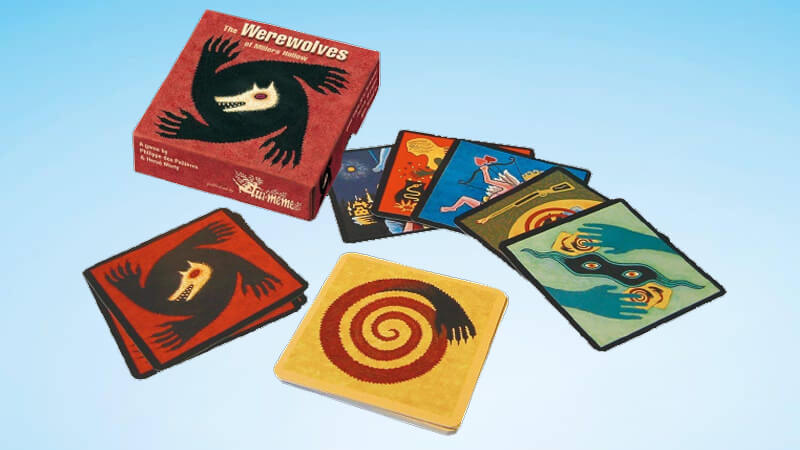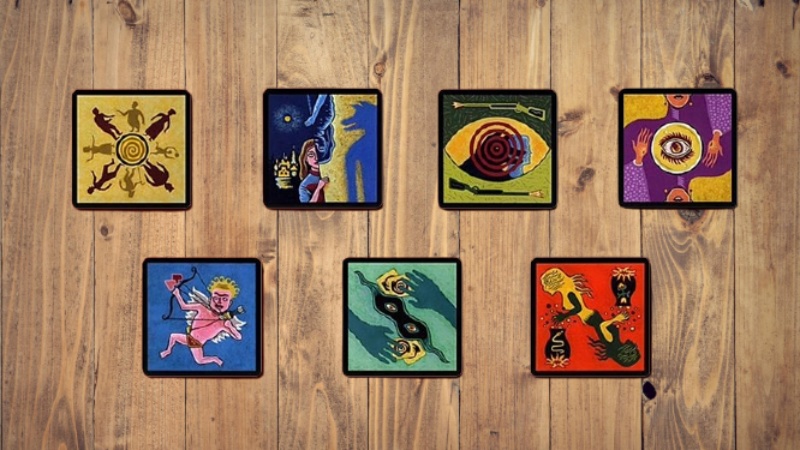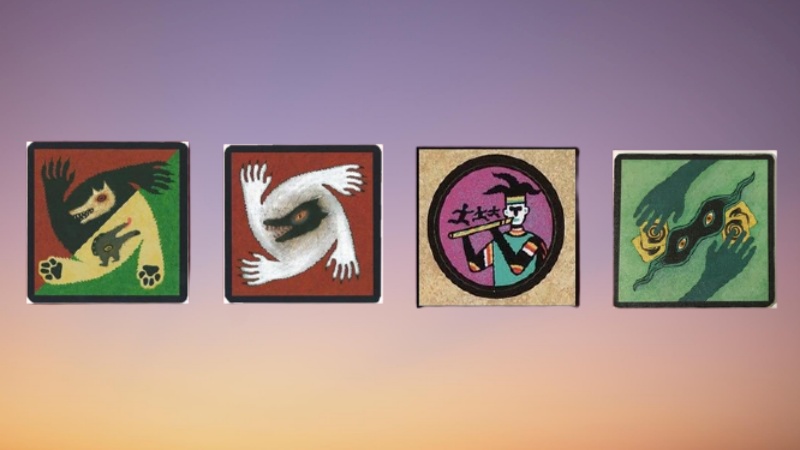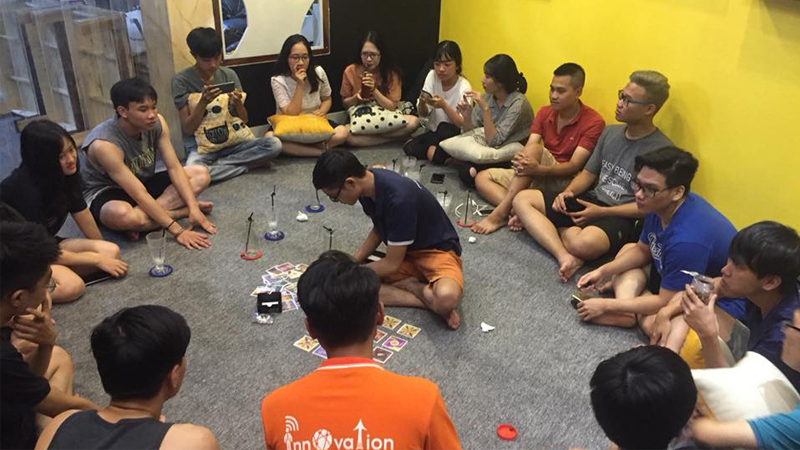Werewolf is an exciting and engaging game that has gained popularity among young people, especially during outdoor activities, camping trips, or as a way to unwind after a stressful day at school. This guide will teach you how to play Werewolf and provide you with the basic rules to get started.
1 Origin of the Game and Story Premise
Origin of the Game
 The Werewolves of Millers Hollow – Werewolf
The Werewolves of Millers Hollow – Werewolf
Reference: Basic Guide for 2 Players
The game of Werewolf, or “The Werewolves of Millers Hollow” in English, was created by Philippe des Pallières and Hervé Marly. Although it is a relatively new game in Vietnam, it has become extremely popular among young people for gatherings and camping trips as it can accommodate a large number of players, ranging from 5 to 47 people.
Story Premise
The game is set in a fictional village during the 5th century BC, a time when werewolves were rampant and posed a significant threat.
The game takes place in a small village by the river, where life used to be peaceful and serene. However, one day, werewolves appeared and disrupted the tranquility of the village.
Werewolves are cunning creatures; during the day, they disguise themselves as ordinary villagers, but at night, they revert to their true form and kill. As a result, the villagers’ lives become filled with tension and fear.
 Story Premise of Werewolf
Story Premise of Werewolf
Unable to live in constant fear, the villagers decide to unite and fight back against the werewolves. Fortunately, among the villagers are individuals with special abilities that can aid in the identification and elimination of the werewolves.
Each day, the villagers hold a trial, and the person deemed most suspicious is sentenced to death by hanging, regardless of their true identity.
The battle between the villagers and the werewolves is a tense and strategic one, as players can lie, tell the truth, or defend themselves and others to either uncover the werewolves or protect their loved ones.
Reference: What is it? Top 15 popular board games
2 How to Play Werewolf
General Gameplay
The game is divided into two parts: night and day. It begins on the first night, where each player is secretly assigned a role by the game master, unknown to the other players. During the night, certain characters will be awakened by the game master to perform their respective actions in silence, after which they will go back to sleep.
For example, the game master may call out: “Werewolves, wake up.” The players assigned as werewolves will open their eyes. The game master then asks: “Werewolves, who do you want to kill tonight?” The werewolves silently point to their chosen victim, after which the game master records the decision and tells them to go back to sleep.

When day breaks, all players wake up and discuss who they suspect to be a werewolf and decide on a person to be hanged. The accused player has five minutes to defend themselves, after which the other players vote on whether to save or hang them.
Additionally, the game may introduce a third faction with the inclusion of additional roles, thus changing the number of werewolves, villagers, and members of the third faction accordingly.
Reference: Simple and Detailed Guide
The game ends when one of the following three conditions is met:
- The werewolf faction has an equal number of members as the villager faction.
- All werewolves are eliminated by the villagers.
- The third faction completes its assigned task.
Basic Rules
First Night:
All players close their eyes and go to sleep. The game master then awakens the players with special roles one by one and instructs them to perform their respective actions in silence. After completing their actions, these players close their eyes again.
First Day:
In the morning, the game master announces the number of deaths that occurred during the night. The players then discuss and decide on a person to be hanged. Depending on the rules, the players may request the game master to reveal the identity of the deceased. The surviving players engage in a lively debate to identify and eliminate the werewolves.
Typically, the discussion period lasts for five minutes, after which the players vote on who they suspect to be a werewolf. The accused player has one minute to defend themselves, and a final decision is made to save or hang them.
Subsequent Nights:
The game master awakens the players with special roles, just like on the first night, and they perform their actions. However, the players do not know how many of each role are still in the game, as the roles are kept hidden until the end.
Subsequent Days:
Similar to the first day, the game master announces the number of deaths from the previous night, and the players discuss and vote on who they suspect to be a werewolf.
End of the Game:
The game concludes when either the villagers eliminate all werewolves, the number of werewolves equals the number of villagers, or the third faction accomplishes its task.
Factions and Roles in the Game of Werewolf
Villager Faction
The primary objective of the villagers is to identify and eliminate the werewolves during the day.
Within the villager faction, there are several special roles:
- Seer (The Seek): Each night, the Seer can choose one person to examine and discover their true identity. The Seer must help the villagers identify the werewolves without being detected.
- Hunter (The Hunter): In the game, if the Hunter dies or is eliminated, they can still choose to kill one additional player. From the second night onwards, the Hunter has the power to kill one person each night.
 Villager Faction
Villager Faction
- Cupid (The Cupid): On the first night of the game, Cupid randomly chooses two people to fall in love. The game master then awakens these two players, and they know each other’s identities and roles. If one of them dies, the other will also die. They cannot vote against each other. In the event that they belong to opposing factions, such as the villagers and the werewolves, their initial objective changes, and they must now eliminate all other players.
- Witch (The Witch): The Witch possesses two potions: one to save a person and one to kill a person. The Witch can use only one potion per game but may use both potions in a single night. Each night, the game master informs the Witch of the previous night’s victim and asks if they want to save that person or kill one of the other players.
- Little Girl: Starting from the second night, the Little Girl can wake up when the werewolves do, but if she is discovered and killed by the werewolves, her life can be traded for the initial victim’s life.
- Village Chief: Any player can be assigned the role of Village Chief in addition to their original role. The Village Chief is chosen based on the votes of the other players. In the event of a tie, the Village Chief’s vote counts as two. If the Village Chief dies, another player can be chosen to take their place.
- Thief (Robber): The Thief’s role is assigned by the game master, who adds two function cards to the deck and distributes them evenly among the players. On the first night, the Thief is awakened and allowed to look at and choose one of the two function cards. The Thief will use this card for the remainder of the game. If one of the cards is a werewolf card, the Thief must choose it.
Werewolf Faction
 Werewolf Faction
Werewolf Faction
The werewolves’ primary objective is to kill all the villagers or ensure that the number of werewolves equals the number of villagers to achieve victory. During the night, the werewolves collaborate to choose a victim.
During the day, the werewolves disguise themselves as villagers and attempt to convince the others that they are not werewolves if accused.
Third Faction
The members of the third faction are challenging to identify as they may belong to the villager faction but also have separate objectives.
- Lovers (Couple in Love): This couple is chosen by Cupid and forms the third faction. Their objective is to ensure their own survival as the last two players standing.
- Tainted Villager (Half-Human, Half-Wolf): Initially, the Tainted Villager belongs to the villager faction, but due to a werewolf bite, they become a werewolf and adopt the werewolf faction’s objectives.
- White Wolf (White Werewolf): The White Wolf wakes up with the other werewolves but has the power to kill another werewolf every other night. Their objective is to become the sole surviving werewolf.
 Third Faction
Third Faction
- Piper (Flute Player): Every night, the Piper can hypnotize two other players of their choice. The hypnotized players are awakened by the game master to know each other’s identities. The Piper wins if all the remaining players are hypnotized.
- Thief: When the game master introduces the Thief role, two additional function cards are added to the deck and distributed evenly among the players. On the first night, the Thief is awakened and allowed to choose one of the two function cards. If one of the cards is a werewolf card, the Thief must choose it.
Setting up the Game Based on the Number of Players
 Setting up the Game
Setting up the Game
- 8 – 9 players: 1 seer, 1 protector, 2 werewolves, and the rest are villagers.
- 10 – 11 players: 1 seer, 1 protector, 1 hunter, 3 werewolves, and the rest are villagers.
- 12 – 13 players: 1 seer, 1 protector, 1 hunter, 1 cupid, 3 werewolves, and the rest are villagers.
- 14 players: 1 seer, 1 protector, 1 hunter, 1 cupid, 1 witch, 3 werewolves, 5 villagers, and 1 traitor.
- 15 players: 1 seer, 1 protector, 1 hunter, 1 cupid, 1 witch, 4 werewolves, and 6 villagers.
- 16 players: 1 seer, 1 protector, 1 hunter, 1 cupid, 1 witch, 1 elder, 4 werewolves, and 6 villagers.
- 17 players: 1 seer, 1 protector, 1 hunter, 1 cupid, 1 witch, 1 elder, 1 piper, 4 werewolves, and 6 villagers.
- 18 players: 1 seer, 1 protector, 1 hunter, 1 cupid, 1 witch, 1 elder, 1 piper, 1 thief, 4 werewolves, and 6 villagers.


































